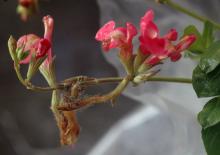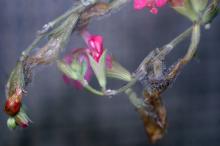See:
Greenhouse Plants, Ornamental - Gray Mold
Cause The fungus Botrytis cinerea is an opportunistic pathogen that easily invades weak, damaged, or senescent tissue such as cotyledons, young stems, and young leaves. Spores are produced throughout the growing season under a wide range of temperatures and humidity. Cool temperatures, high humidity, and free water on plant surfaces favor the disease, as do close plant spacing and irrigation practices that keep plants wet for a longer time.
Symptoms All aboveground portions of the plant are attacked. The initial symptom is a dark, water-soaked, slimy lesion, with concentric zonation and sometimes a yellowish margin. Long brown streaks form on petioles. As tissues dry out, gray, powdery spore masses form. Sclerotia may also develop.
Cultural control
- Maintain good air circulation in row and plant spacing.
- Use drip irrigation.
- Avoid high nitrogen fertilization.
- Ideal growing conditions include a pH of about 5.8 and day temperatures of 71°F to 79°F and 62°F to 67°F at night.
- Maintain a steady, relatively dry environment by keeping greenhouse humidity below 90%, increasing spacing between plants for good air circulation, and taking care not to splash water on foliage during watering. Heating the greenhouse at night (especially for zero or negative DIF) or venting around sunset may be necessary. Heating in the morning before sunup can also help prevent dew formation as air temperature increases faster than the temperature of plant parts. If using DROP or DIP for size control, do not let humidity rise above 90%.
Chemical control Best used with cultural controls. Tank-mix and/or alternate products with different modes of action to prevent the buildup of resistant fungi. Limit the use of any one group during crop production.
- Chipco 26019 FLO at 1 to 2.5 quarts/100 gal water. Group 2 fungicide. 12-hr reentry.
- Decree 50 WDG at 0.75 to 1.5 lb/100 gal water. Do not use more than twice sequentially. Group 17 fungicide. 12-hr reentry.
- Medallion WDG at 2 to 4 oz/100 gal water. Using with oils or adjuvants may damage plant. Group 12 fungicide. 12-hr reentry.
- Palladium at 4 to 6 oz/100 gal water. Avoid excessive runoff to small plants, which may result in stunting and/or chlorosis. Group 9 + 12 fungicide. 12-hr reentry.
- Phyton 27 at 1.3 to 2 oz/10 gal water. Group M1 fungicide. 48-hr reentry.
- Protect DF at 1 to 2 lb/100 gal water plus 2 to 4 oz spreader-sticker. Mancozeb-based products can be used as mixing partners and provide some protection. Group M3 fungicides. 24-hr reentry.
- Spirato GHN at 2 to 4 fl oz/100 gal water. Use with oils or adjuvants may cause plant damage. Group 12 fungicide. 12-hr reentry.
- Switch WG at 11 to 14 oz/A is registered for the herb Salvia officinalis. Do not use within 7 days of harvest. Group 9 + 12 fungicide. 12-hr reentry.
- Terraguard SC at 4 to 8 fl oz/100 gal water. Group 3 fungicide. 12-hr reentry.
Reference Garibaldi, A., Bertetti, D., Ortega, S. F., and Gullino, M. L. 2016. First report of botrytis blight caused by Botrytis cinerea on fruit-scented sage in Italy. Journal of Plant Pathology, 98:179.



